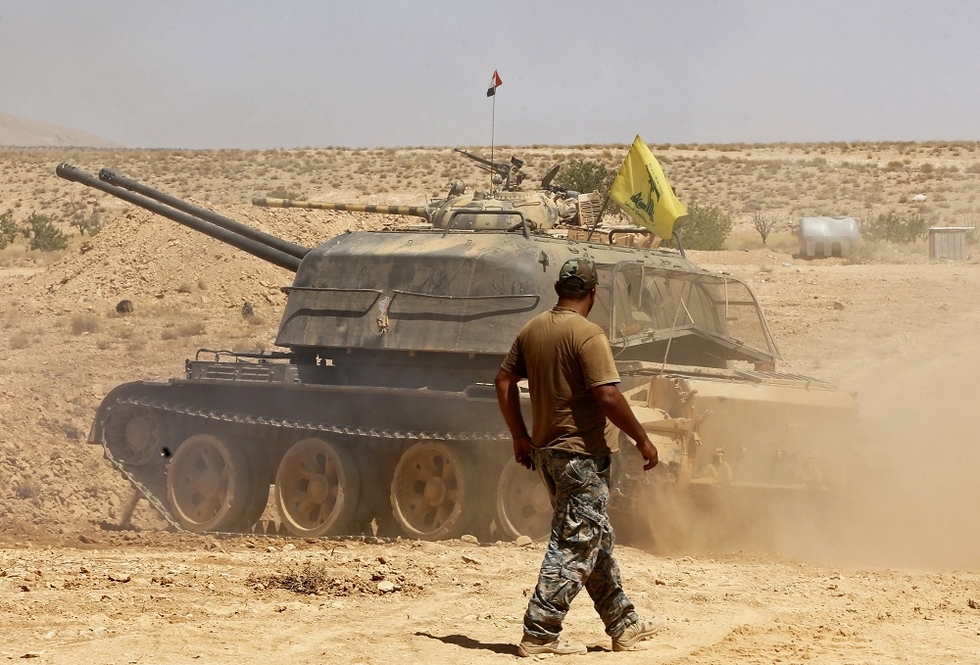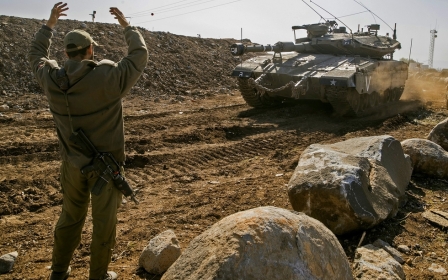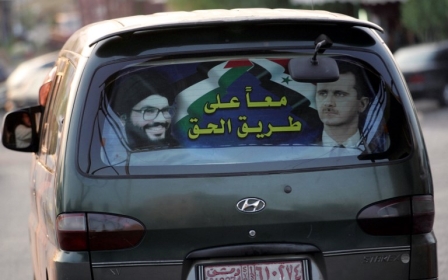Hezbollah has 10,000 men facing Israel's Golan, claims commander

Hezbollah is using a "de-escalation" deal brokered by Russia and the US to pour thousands of battle-hardened soldiers into southern Syria and entrench its positions for a possible confrontation with Israel, a commander told Middle East Eye.
The commander, speaking on condition of anonymity, said there were 10,000 Hezbollah fighters in areas along the disputed Golan Heights frontier, and that missile bases and tunnel networks were being built.
Hezbollah has over 10,000 fighters in southern Syria. We are working with more freedom, there are no more bombings
- Hezbollah commander in southern Syria
“The de-escalation plan is better for us," he said. "We are working with more freedom, there are no more bombings."
"Hezbollah has over 10,000 fighters deployed in southern Syria. Hezbollah is an army of infantry, rockets, tanks, elite forces. We are operating as we do in south Lebanon, but of course in a veiled manner."
The US-Russia de-escalation plan introduced ceasefires in July to minimise casualties in several flashpoint regions of Syria's civil war.
The interview was conducted days before simmering tensions boiled over on Tuesday, when Israel shot down a Hezbollah reconnaissance drone it said was threatening its airspace in the disputed Golan Heights.
The Hezbollah commander's claims may raise alarms within the Israeli military as it faces the prospect of the Iran-backed Lebanese group dug in along its Golan frontier, in what one analyst says will act as another "point of intimidation" to add to Lebanon's southern border and the Bekaa Valley.
Israel and Hezbollah last fought openly in 2006, in a 34-day conflict where a largely untested Hezbollah force was able to repel an Israeli ground invasion of southern Lebanon.
Since then, the group has gained six years of combat and tactical experience in Syria, fought alongside Russian specialists and has spread out from its Lebanese base.
Last Thursday, the Israeli army concluded its largest military exercise in almost two decades, operation "Light of the Grain", which simulated a Hezbollah offensive against Israel’s northern border and saw the deployment of tens of thousands of Israeli soldiers.
Nicholas Blanford, a Hezbollah expert at the Atlantic Council, said that while he believed claims of 10,000 Hezbollah soldiers on Israel's border was wildly exaggerated, there was undoubtedly a long-term ambition to gain a toehold in the Golan.
"It is another point of intimidation for the organisation against Israel," he said. "Hezbollah has been active in the last few years in southern Syria, as seen in the targeting of some of its members there."
In January 2015, Jihad Mughniyeh, the son of Hezbollah’s military leader Imad Mughniyeh, was killed in the Syrian province of Quneitra near the Israeli-controlled Golan Heights. Four other Hezbollah fighters were killed in the strike.
In December 2015, Syrian reports claimed Israel killed Hezbollah member Samir Kuntar in a missile attack near Damascus. It was believed Hezbollah was training militiamen and Syrian government forces in the the Golan area, later to be led by Kuntar.
Kassem Kassir, a Lebanon-based journalist with close ties to Hezbollah, told MEE that the recent drone incident was the latest in a "tit-for-tat war" being fought between Hezbollah and Israel via Syria.
"It is a message to Israel following the bombing by the Israeli air force of a Syrian base,” he said, in reference to the destruction of a Syrian government facility in the northwest of the country earlier this month that Israel said was part of a chemical weapons programme.
Kassir agreed that the de-escalation plan in Syria had provided the necessary stability for Hezbollah to establish a military infrastructure, although he stressed that he could not independently confirm what had been constructed by Hezbollah.
Despite all the speculation, the balance of terror still holds
- Nicholas Blanford, Atlantic Council
However, Kassir said that for now, southern Syria may remain calm as Hezbollah is occupied elsewhere in Syria.
“The focus of Hezbollah is for now on the Badia [an area of Syria], and on the fight against the Islamic State and not on southern Syria," he said.
Blanford agreed. "Despite all the speculation of another war being imminent, the balance of terror between Hezbollah and Israel, which has helped maintain stability for 11 years, still holds."
The Hezbollah source said that while the next war with Israel might start from Syria, "what really matters is where will it end, will it be in Natanya, Haifa or Kiryat Shmona?"
This article is available in French on Middle East Eye French edition.
New MEE newsletter: Jerusalem Dispatch
Sign up to get the latest insights and analysis on Israel-Palestine, alongside Turkey Unpacked and other MEE newsletters
Middle East Eye delivers independent and unrivalled coverage and analysis of the Middle East, North Africa and beyond. To learn more about republishing this content and the associated fees, please fill out this form. More about MEE can be found here.






